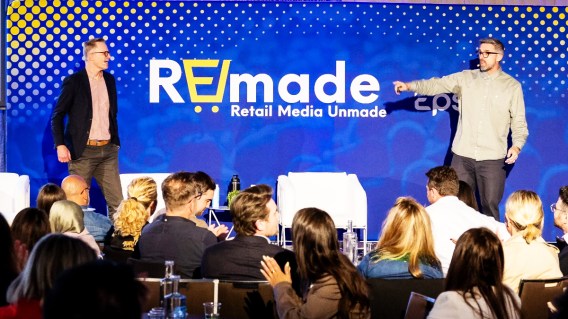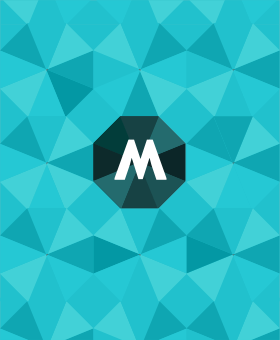
How Commonwealth Bank slowly became a national media network

Jonathan Hopkins, co-founder of Sonder, and Patrick Crowley, GM of paid and owned media at CBA, at the Remade retail media conference on Tuesday, in Sydney
It might not be its main focus, but Commonwealth Bank has one of the country’s biggest media networks.
There are still over 640 physical branches, with big media walls beaming out video content in-store. There are also 1,800 ATM screens scattered across Australia, a website with 7 million monthly users, and an in-app loyalty club that serves deals to over 2 million people each month. Three in five Australians interact with the bank, and each day over a billion dollars moves through the app alone.
However, according to Patrick Crowley, Commonwealth Bank doesn’t actually run a “retail media network” — nor does it use the term.
Crowley is the bank’s general manger of paid and owned media. As he explained at Tuesday’s Remade retail media conference in Sydney, the bank’s media play, Commbank Connect, is technically an ‘owned media network’.
After all, it’s not a retailer, as Crowley pointed out, it’s a bank.
While the difference might seem pedantic and semantic, it actually represents a larger hurdle.
Retailers are designed to sell to customers — banks, by and large, are not. There’s a psychological barrier, and bank customers don’t want to feel like an advertising mark, particularly when the commercial seems targeted at them specifically. After all, the bank is trusted with your most precious financial data.
In 2016, Jonathan Hopkins, co-founder of Sonder, was brought in to help leverage CBA’s channels. Sonder builds retail media networks for businesses, and he was tapped to do this for the country’s largest bank.
Enjoying Mumbrella? Sign up for our free daily newsletter.
The way Sonder achieved buy-in from the Commonwealth Bank C-suite was to put a dollar value on the company’s owned media channels. This was 2016, “when owned media was just a very small embryo in the world, and there certainly wasn’t a consensus about it,” as he told the conference.
“It was worth hundreds of millions. So we put a value on that for the business … And that really helped, internally, the stakeholders understand the value of owned media.”
Originally, these channels were simply used to cut marketing budgets within CBA. An advertising campaign for a home loan offering might cost $3 million instead of the usual $5 million, due to the increased percentage of owned media in the overall channel mix.
Crowley was working at Ikon Communications at the time, managing CBA’s communications planning and trading. He recalled reducing the bank’s paid campaigns from 150 to 100 “pretty much overnight”, once the worth of its earned media channels became apparent.
CBA’s internal research found that messaging within its own channels was three times more likely to be recalled later by its customer than its external advertising. This was a valuable asset it was building.
In 2017, the bank ran a quick survey on its ATM screens asking a bunch of multiple choice questions about the Australian dream, such as “Is the Australian property dream still a reality?” and “Do our kids have the skills they need for tomorrow?”
The insights gleamed from the responses — widespread worry about the cost of living, and financial security in old age — fuelled a larger advertising campaign.
“But the signal it gave the organisation was that consumers were willing to lean into something more than just their transacting on an ATM machine at that point in time,” Crowley said.
“So owned channels did become a two-way platform that allowed us to gather information in this case, but also kind of opened the eyes of most of us to go, ‘Hey, we can start using this for a bit of different stuff’.”
The rise of apps over the next few years soon meant banking customers were using their phones to check balances, transfer money, and manage their finances. Commbank had yet another screen to sell from – and it was inside the customer’s pocket.
This is when CBA started to “think about sensitive commercialisation and ways that you can do that”, as Hopkins put it. The bank started with its existing card partners, moving past a simple co-branded piece of plastic to a carousel on the Commbank homepage, and wrapping this value into the overall partnership deals. Then they introduced its in-app offers program, giving customers product deals — for example, flight discounts through Qantas, or Myer coupons.
“That was the first baby steps into commercialisation,” Hopkins said. They had to tread carefully, because banks rely on customer trust.
“We worked out a monetisation strategy, but we also understood that we couldn’t just be slamming ads all over the place,” Crowley said.
By 2022, the entire media landscape had shifted.
“We’re seeing fragmentation and consumption changes. We’re seeing advertising in its traditional form not working as hard as it used to,” Crowley recalled. “But we are starting to see the role of content play a really heavy lifting role in how we communicate with customers. So at that point in time, we went, ‘We’re going to need a content play here’.”
This led to the launch of Brighter magazine, in conjunction with Medium Rare. “A lot of people laughed at us at that point, right?”
Now, they print 140,000 copies of each issue, six times a year, with the content being recycled on its social media posts and website. The obvious next step was the Brighter TV show, which is currently airing its second season on 10. Both of these plays allow for commercial advertisers, without it seeming like overreach. People expect advertising in free magazines and on free-to-air TV.
Commonwealth Bank has 50,000 employees and around a thousand projects happening at any time. Getting the organisation to approve the production of a print magazine was “a big conversation”, Crowley recalls, but again, it helped to have buy-in from the very top. He joked that if CEO Matt Comyn and CFO Alan Docherty weren’t on board with the owned media concept, he would “still be running around the organisation trying to put one new screen in one new branch.”
This all led to the creation of Commbank Connect, the bank’s owned-media network, which launched last October. In the year since, the bank has run over 20 campaigns for partners, including Kayo, Mastercard, and Qantas.
“We haven’t had a single customer complaint,” Crowley said. “So, to me, that’s a measure of success, and it actually means that the environment is trusted and consumers are OK with it. The number-one focus here is customers; knowing that they’re feeling comfortable about things obviously gives us a lot of confidence in the product we’re building.”
After testing the public temperature with “soft stuff for partner-partners, not paid partners”, the bank is now running full-funnel campaigns for other clients.
Destination Canada is currently running a campaign to convince Australians to head to Canada over Christmas.
Crowley explained this consists of “beautiful imagery in branches, content in the magazine, content on our social pages, right through to a click-to-book-a-flight or accommodation through the travel booking hub on the Commbank app.”
There are self-imposed limits to this commercial play.
“We won’t work with thousands and thousands of people,” Crowley said. “It’s not going to become a shopping centre of advertising. It’s got to be the right people, the right place.”
He noted: “There’s a lot of signals we’re getting about what people are spending money on, which is a real critical part about why we think the product is sustainable and a worthwhile product in the wider media landscape.”
It’s also why the bank needs to tread carefully.
“We don’t deliver one-to-one comms,” Crowley said. “We deliver cohort comms. We understand where groups of people are and the locations they’re at and put them into groups.
“Ideally, no one’s feeling creepy about the one-to-one thing. They’re getting a relevant message. I’m a believer that in any marketing, if it’s relevant, people won’t feel like it’s creepy.
“We’re also not going beyond our network. We’re not going to create a traceable off-network. That’s definitely not our play.”
Another area Commbank Connect isn’t dabbling in is artificial intelligence. “It’s not playing a role at the moment,” Crowley said. “It’s probably a conversation we’re all having in our organisations. It’s slowly but surely.
“We’re using AI through lots of parts of the bank. It’s definitely not being inputted into Commbank Connect right now.”
Aside from being an advertising play, the rise of the bank’s owned media network has also improved the physical nature of the bank.
“One of the biggest reasons for Commbank Connect is to pour all the money, any money we do make, back into the customer experience,” Crowley explained.
“I don’t think we need to make the couple of million bucks to help our overall number. What we need to make is a couple of million bucks to make sure the customer experience in the branch network and in our assets is really, really good.
“And that’s important, I think, to know the primary focus of this is ultimately going back to the customer.
“I think if we have that future vision and focus, we won’t deviate from delivering upon that.”
The millions have instead gone into upgrading the old infrastructure. After all, scaling an offering like this involves a lot of physical change.
“The flip side of operating in something like Commbank is the ferocity and the speed at which you have to deliver things if you said you would. How do we scale it?
“[There’s] 650 branches. There were branches with wires hanging out of the roof. There were roof panels off. There were DVD machines still in there. There were posters.
“This is a big legacy network that needed to change, and part of our remit was really cleaning it up.”







